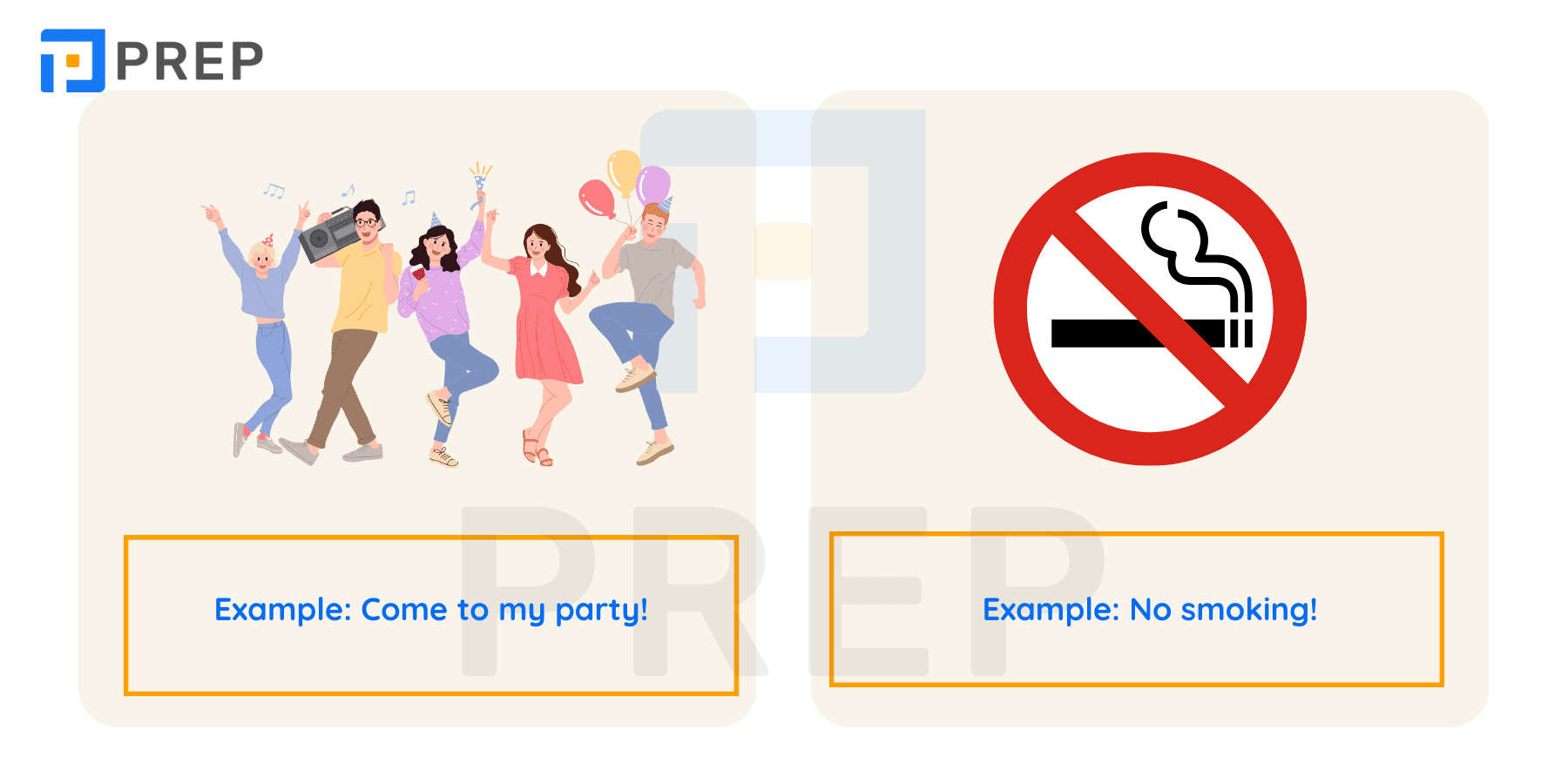Imperative Clauses in English: Rules and Examples
Imperative clauses are used to give orders, instructions, advice, or suggestions in English. This guide explains how they work, common sentence structures, and useful examples to help you apply them correctly in daily communication and exams. Practice with exercises.

I. What Are Imperative Clauses?
In English, imperative clauses are used to give instructions, commands, advice, or suggestions. They are one of the core sentence types in English communication and appear often in both spoken and written language — especially in directions, rules, recipes, warnings, and everyday interactions.
Key characteristics of imperative clauses
- The subject “you” is usually omitted, because it's understood implicitly.
Example: (You) Close the door. - The verb appears in its base form (bare infinitive) at the start of the clause.
Example: Please sit down. - Punctuation often includes a period (.) or an exclamation mark (!) for emphasis.
Imperative clauses are used in several ways depending on intent and context:
- To command or instruct
- To make a request (more polite with “please”)
- To offer advice or suggestions
- To give warnings or set prohibitions
Because of their frequency and functional variety, imperative clauses are essential for learners to recognize and produce naturally — especially in test settings like IELTS Writing Task 1 (when describing processes) or in Listening sections with instructions.
Alongside declarative, interrogative, and exclamatory forms, imperatives are part of the main types of sentences in English that every learner should master.

1. Grammar Rules and Structures of Imperative Clauses
Imperative clauses are typically straightforward in form, but they can take on different structures depending on tone, intent, or emphasis. Many imperative sentences are short and direct, yet their grammatical patterns serve a wide variety of functions, from giving instructions to offering suggestions or issuing warnings.
Common Sentence Patterns
Here are the most widely used structures of imperative clauses along with examples:
|
Structure |
Usage |
Example Sentence(s) |
|
Verb (base form) |
Direct command or request |
Close the door. / Listen carefully. |
|
Do / Don’t + Verb |
Adding emphasis (do) or giving prohibitions (don’t) |
Don’t be late. / Do take your time. |
|
Let’s + Verb |
Inclusive suggestions |
Let’s begin the session. / Let’s take a short break. |
|
Never + Verb |
Strong prohibition or moral advice |
Never give up. / Never lie to your team. |
|
Let + someone + Verb |
Instruction or permission for someone to act |
Let him speak. / Let me explain this part. |
Negatives in Imperative Clauses
|
Form |
Function |
Example |
|
Don’t + Verb |
Prohibition or instruction not to do something |
Don’t talk during the movie. |
|
Never + Verb |
Strong warning or value-based advice |
Never share your password with strangers. |
Common confusion:
- Don’t forget typically refers to a specific task or reminder.
- Never forget is stronger and often used for life lessons or values.
Incorrect: You don’t open the window!
Correct: Don’t open the window!
Tenses and Passive Forms in Imperative Clauses
- Tense usage: Imperative verbs are in the base form, implying present or near-future action.
Example: Call me after the meeting. - Passive voice: Imperatives can be expressed in the passive form, often in formal or instructional contexts.
Examples:- Be reminded to check your email daily.
- You are advised to arrive 10 minutes early.
Using the passive voice in imperatives adds formality and is common in written notices, safety instructions, or official communication.
To compare with other forms, check how negative sentences in English are structured differently.

2. Functions and Uses of Imperative Clauses
Imperative clauses are not only used to give orders. Depending on the tone, context, and phrasing, they serve multiple communication purposes — from giving instruction to expressing encouragement, issuing warnings, or even making polite invitations.
Commands and Instructions
This is the most common function of imperative clauses — to tell someone to do (or not do) something in a clear and direct way.
- Turn off the lights when not in use.
- Please take a seat.
- Fill in this form before the appointment.
Often used in:
- Classroom language
- Recipes or procedure texts
- Workplace instructions
- IELTS Writing Task 1 (Process)
Invitations and Suggestions
Imperatives can be used to invite or encourage others in a friendly or casual way. These are softer and often include polite cues or friendly expressions.
- Come to my party this weekend!
- Let’s have lunch together.
- Join us for a coffee?
Imperatives used this way are especially common in spoken English and informal writing.
Warnings and Prohibitions
When urgency or danger is involved, imperative clauses are used to warn, prohibit, or alert someone:
- Don’t touch that wire!
- No smoking here.
- Stay behind the yellow line.
Forms often include:
- Don’t + verb
- No + V-ing (in notices or signs): No parking, No entry
This usage is important for safety messages, public signage, and formal written notices.
Advice and Reminders
Imperatives can also function as gentle advice or helpful reminders, especially when used with a calm tone or softened with words like “please.”
- Don’t stay up too late.
- Take care of your health.
- Remember to proofread your work before submitting.
Unlike strict commands, this usage aims to support, remind, or encourage.

II. Imperative Clauses in English Exams
Imperative clauses frequently appear in standardized English exams such as IELTS, TOEIC, and TOEFL—especially in contexts that involve giving instructions, understanding procedures, or describing processes.
Imperatives in IELTS Writing Task 1 (Process Descriptions)
In the IELTS Academic Writing Task 1, when describing a process, imperative clauses are appropriate and often preferred, especially when presenting procedural steps directly.
Examples:
- Add water to the mixture and stir well.
- Heat the solution to 80 degrees Celsius.
- Then, transfer the liquid into the second container.
These examples use imperative verbs to clearly explain actions in sequence, helping to organize ideas and demonstrate task completion.
Tip: While the passive voice is also accepted (e.g., The solution is heated), using active imperatives can show fluency and coherence—if used consistently and logically.
Imperatives in Listening and Reading Sections
In IELTS Listening or TOEIC Listening, imperatives are commonly used in:
- Instructions during form-filling tasks
Please write your name in capital letters. - Public announcements or directions
Turn to Section 3 of the booklet now. - Telephone conversations
Be at the station by 7 AM.
Understanding these structures helps test-takers follow directions accurately and avoid simple errors based on missed details.
Imperatives in Speaking Tasks or Emails (TOEIC)
While less common in spoken responses, imperatives can appear in formal spoken roleplay or prompted writing tasks where learners might need to give advice, instructions, or reminders.
Possible scenarios include:
- Advising a colleague: Try contacting the client again tomorrow.
- Giving a phone message: Tell her I’ll be five minutes late.
Tips for Using Imperatives in Exams
- Use imperative clauses when writing step-by-step processes with clarity.
- Use polite cues (please, let’s) when appropriate in emails or dialogues.
- Listen for imperatives in instructions—they often guide what to do next.
- Avoid mixing imperative and declarative forms inconsistently in writing tasks.
III. Exercises on imperative clauses with detailed answers
To strengthen your understanding of imperative clauses, let’s practice with a series of interactive grammar exercises. These cover common patterns, negative forms, and sentence transformations. Each activity is followed by key answers and brief explanations to help you review effectively.
Exercise 1: Complete the Sentences
Fill in the blanks with an appropriate imperative form of the verb(s) in parentheses.
- ________ (turn) off the lights when you leave the room.
- Don’t ________ (talk) while the teacher is speaking.
- ________ (be) on time tomorrow, please.
- ________ (not / use) your phone during the meeting.
- Let’s ________ (have) a quick lunch before the test.
Exercise 2: Identify the Imperative Clause
Underline the imperative clause(s) in the following sentences.
- Please read the instructions before you begin.
- She asked me to clean the table.
- Don’t forget to submit your report on time.
- Be careful when crossing the road.
- Let me explain my idea first.
Exercise 3: Rewrite in Imperative Form
Rewrite the following polite or indirect sentences using imperative clauses.
- Could you please help me carry this bag?
- I suggest that you take a break soon.
- Would you mind turning down the volume?
- Please make sure you call back before 5 PM.
- I’d appreciate it if you could send me the file.
Answer
[prep_collapse_expand open_text="View more" close_text="Show less"]
|
Exercise 1 |
Exercise 2 |
Exercise 3 |
|
|
|
[/prep_collapse_expand]
IV. Master IELTS With Confidence
Achieving your dream IELTS band score is closer than you think. Our expert-led courses provide personalized strategies, real-world practice, and proven techniques to help you excel in every section of the exam
-
IELTS online coaching: Start Your Journey to IELTS Success Today!

Hi I'm Chloe, and I am currently serving as an Product Content Administrator at Prep Education. With over five years of experience in independent online IELTS study and exam preparation, I am confident in my ability to support learners in achieving their highest possible scores.
Comment
Premium content
View allPersonalized roadmap
Most read












